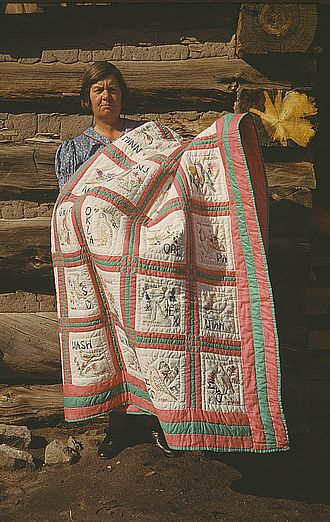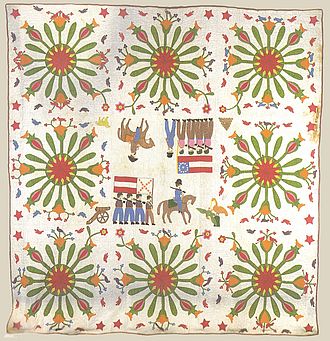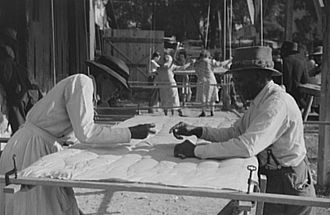Introduction
Carefully stitched flour sacks, calicos, ginghams, muslins, silks, and velvets—intricate circles, blocks, and figures—indelible political, military, social, and religious messages—all embedded within textile treasures, all visualizing particular segments of history in tangible, textured ways.
Quilts reveal cultural, economic, social, and gender history. Often created for ceremonial purposes—weddings, babies, friendship, coming-of-age, departure, death—these textile pieces capture relationships from family and local community, as well as recording events, political and social sentiments, and commemoration with unique female participation. Carefully preserved and passed down through families, then often on to historical societies and museums, these fabric scraps carry with them stories, memories, and historical detail in their patterns.
Traditionally a distinctly female activity, quilting often demonstrates a propensity for the Victorian age’s feminized Cult of Domesticity. Acting from a moral injunction to create beauty for the home, these women utilized social trends in their patterns and designs. Quilt historian Suzanne Yabsley comments: “A quilt is at once simple and complex. Nothing could be more basic than a warm cover. However, the significance of the quilt to its maker carries it far beyond its function into the realms of artistic expression, personal statement, social interaction, and emotional commitment.”1
Popular quilt patterns attest to rhetorical and social values. According to Van E. Hillard, “As cultural forms, quilts readily lend themselves to rhetorical scrutiny. . . . As rhetorical forms, many quilts transform and enrich our notions of the agents, actions, purposes, and scenes of art production and individual creativity, . . . providing a vehicle for subverting dominant ideologies; quilted texts enacted alternate readings of the world.”2 Floral motifs, landscape designs, medallion quilts, album quilts, freedom quilts, crazy quilts, patterns such as the Log Cabin, Drunkard’s Step, Rose-of-Sharon, Rail Fence, Courthouse Steps, Trip Around the World, and countless others with numerous variations demonstrate underlying ambitions, hopes, aspirations, morals, and current circumstantial sentiment.
Quilts disclose valuable historical information about several diverse communities of creators. Church groups stitched quilts for benevolent and missionary efforts. Slave quilts divulge details about a seemingly silent segment of nineteenth-century population; Underground Railroad quilts delivered textile messages to a non-literate people, and particular patterns, colors, and fabrics indicate African and African-American cultural propensity.3 Pioneer trail quilts, most often transported for utilitarian purposes, also contained sentimental messages as women and their families left friends, neighbors, and kin to start new lives on the frontier. Quilts from geographical regions showcase local materials, patterns, and techniques, documenting visual change over time.4
Fabric seemed an inherently natural mode of female expression as nineteenth-century women were expected to provide warmth and nurture for their families and communities. Stitched within such orthodox domestic traditions, however, were additional messages. Political sentiment flowed from women’s needles as they gathered and quilted in support of suffrage, temperance, military campaigns and war relief, and political parties. Women who couldn’t vote signed their quilt blocks with pride. Quilts became banners, flags, and fabric petitions, displaying strong political voices.5 Groups used quilts to raise money as well as to raise visible public support. Fairs, festivals, and bazaars displayed and sold quilts, while later museums exhibited them as precious pieces of the past. Textile remnants reveal as much as written text found in journals, newspapers, correspondence, and memoirs.
Quilt patterns, fabrics, and methods indicate valuable mechanical and economic historical details. The finished product reveals economic class. Slaves pieced work for their white mistresses; underpaid girls worked in textile mills; Victorian ladies of leisure pieced together crazy quilts of rich velvets, indicating a quilting transformation from necessity to décor. And in between were women stitching for their families and communities, providing warmth, beauty, and sentiment. All contributed to a textile social stratification.
The mid-nineteenth century idea of quilts proved an important American sentiment. Homespun and homegrown artifacts came to represent symbols of Jeffersonian ideals of a sturdy, self-reliant, agricultural population as a source of democratic values.6 As the Industrial Revolution mechanized factory-produced blankets, the nostalgic charm of homemade quilts withered. Patchwork came to be viewed as backwards and un-modern.
Later in the twentieth century, however, a resurgence in old fashioned quilts surfaced. As Americans celebrated the bicentennial of the country, they turned to the past to refashion traditional values. Museums started to display quilts, and material culture historians viewed textiles as embodying important social, cultural, and material assets. Amish quilts sold as a marketable cultural commodity, and quilting circles and specialty shops materialized. Scholars began to examine quilts and their makers in earnest, discovering valuable academic contribution from scraps of fabric.
Between the stitches, the fabric, and the batting, quilts can reveal valuable details about their makers, time periods, and uses. As pieces of visual history, careful study of quilts demonstrates fragments otherwise lost to oblivion.



